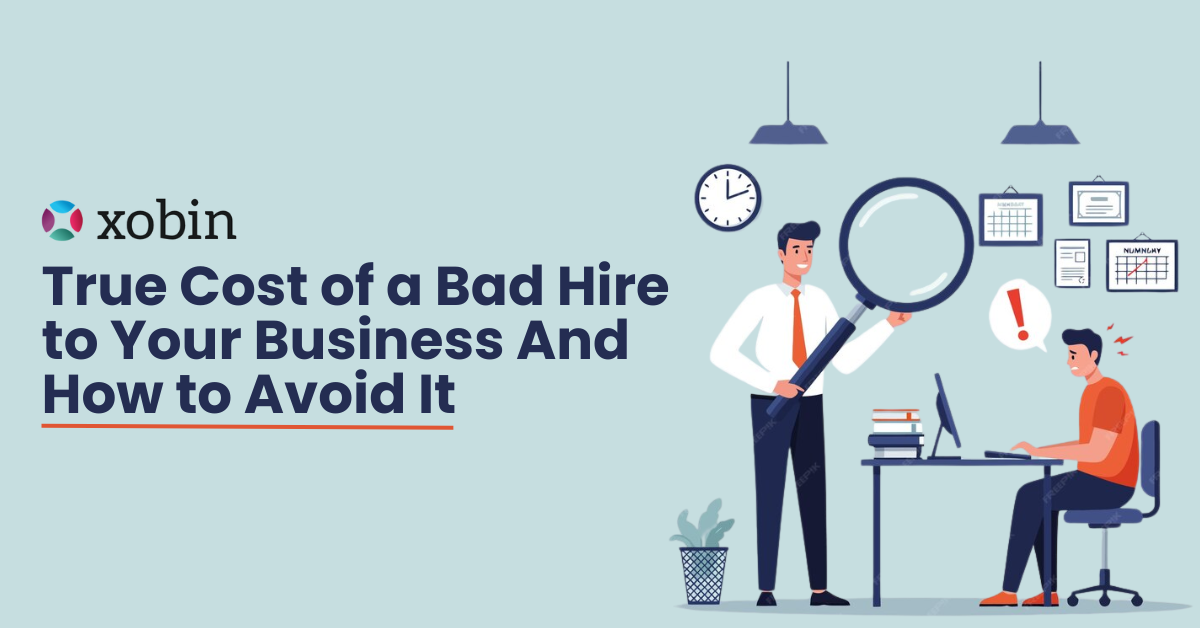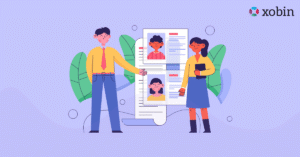Hiring the right candidate for your company is crucial, not only for growth but also for the overall success of your business. However, the cost of a bad hire can be significant, affecting everything from productivity to company morale and even your bottom line. In today’s competitive hiring landscape, recruiters need to understand the real cost of a bad hire and how to handle it. This knowledge will not only help streamline the recruitment process but also ensure you make smarter, more cost-effective hiring decisions.
Table of Contents
In this blog, we’ll help you understand the true cost of a bad hire, how it’s calculated, the key reasons behind it, and, most importantly, how to avoid it. So, if you’re looking to optimize your hiring strategy and reduce costly mistakes, this guide is just for you.
Let’s dive in.
What is the Real Cost of a Bad Hire?
Hiring the wrong person doesn’t just affect one role, it impacts your entire business. The cost of a bad hire includes more than just the salary or onboarding expenses. It also leads to lost productivity, low team morale, unhappy clients, and wasted time on hiring and training all over again.
According to the U.S. Department of Labor, a bad hire can cost up to 30% of the employee’s first-year earnings. Some research shows that the actual cost could be even higher when you include hidden losses like poor performance, missed deadlines, and disrupted workflows.
Many recruiters focus only on the direct costs of recruitment. However, the true cost of a bad hire goes far beyond that. It affects multiple departments and slows down company growth. Worse, the consequences can continue for months or even years.
Let’s break down the hidden cost of a wrong hire:
Financial Impact
If you’re hiring for a leadership position or a revenue-generating role, the losses can be even greater. According to CareerBuilder, 75% of companies admit they’ve hired the wrong person for a position, and the average cost of a bad hire is $17,000.
Operational Disruption
A bad hire can also disrupt the entire team’s workflow. This often leads to delays in project timelines and can put unnecessary stress on other employees, leading to a decrease in overall productivity.
The Impact on Team Morale
When a bad hire doesn’t perform well, it doesn’t just affect them. It impacts the entire team. Team members may have to pick up the slack, and that can create resentment, frustration, and burnout. This can lead to a drop in employee engagement and morale.
Damage to Company Culture
The cost of a bad hire extends to company culture. If a new employee doesn’t fit in with your company’s values or has a negative attitude, it can lower the overall spirit of the workplace. Employees might feel demotivated, which can affect retention rates.
Loss of Clients or Revenue
A bad hire who interacts with clients or customers can directly impact your business revenue. They might mismanage relationships, make poor decisions, or fail to deliver on promises, leading to customer dissatisfaction. This can result in lost contracts, damaged reputations, and reduced future revenue.
Legal Costs
In some cases, bad hires can result in legal action. Whether it’s for discrimination, wrongful termination, or failure to meet specific job qualifications, dealing with legal matters can be costly and time-consuming. This can also damage your company’s reputation.
The Time It Takes to Recover
After realizing that a hire is not working out, replacing that employee takes significant time. The recruiting process starts all over again, costing you not just money but valuable time that could be spent on growing your business.

How to Calculate the Cost of a Bad Hire?
To calculate the cost of a bad hire, you need to consider both direct and indirect expenses.
Direct Costs
These are visible and easier to quantify:
- Recruitment expenses: Job ads, recruiter fees, and interview time.
- Training and onboarding: Time and resources spent on initial setup.
- Salary and benefits: Paid to an underperforming or mismatched hire.
- Termination costs: Severance pay and possible legal fees.
Indirect Costs
These can be more damaging and harder to calculate:
- Lost productivity: A bad hire slows down team output.
- Time wastage: HR and team members lose hours in managing or replacing the employee.
- Team morale: One bad hire can disrupt harmony and motivation.
- Client impact: Errors or poor service can damage customer relationships.
- Opportunity cost: Time lost on the wrong candidate means missing out on better talent.
Formula to Estimate the Cost of a Bad Hire:
Cost of a Bad Hire = Direct Costs + Indirect Costs
Why Does the Cost of Bad Hires Appear in Your Business?
The cost of a bad hire doesn’t just appear out of nowhere. It’s the result of broken or outdated hiring practices that fail to identify the right candidate from the start. Many businesses underestimate how even small inefficiencies in their recruitment process can lead to expensive mistakes down the line.
Here are some common reasons why the cost of a bad hire creeps into your business operations:
Lack of Standardized Hiring Processes
Without a structured approach to recruitment, decisions often rely on gut feelings or inconsistent evaluations. This increases the risk of hiring someone who doesn’t align with the role or your company culture.
Time Pressure to Fill Roles Quickly
When a position remains vacant for too long, it affects productivity. In response, hiring managers may rush to fill the role without conducting proper pre-employment testing. This urgency often compromises quality, leading to high bad hire costs in the long run.
Overreliance on Resumes and Interviews
Resumes highlight what a candidate wants you to see. Traditional interviews, meanwhile, can be influenced by charisma rather than competence. This makes it hard to assess actual job readiness, especially for roles requiring technical or soft skills.
Misaligned Job Descriptions
A poorly written job description or vague role expectations can attract the wrong type of candidate. This mismatch can lead to underperformance and early exits, contributing to the cost of a bad hire.
Overlooking Cultural Fit
Skills matter, but so does cultural alignment. A candidate may perform well technically but clash with your team’s values or communication style. This mismatch can harm team cohesion and productivity, adding to hidden hiring costs.
Ignoring Data-Driven Insights
Today’s hiring tools offer powerful data from test results to behavioral analysis. Ignoring these insights can lead to hiring decisions based on assumptions, not facts. This oversight can significantly contribute to the cost of a bad hire.
Inadequate Use of Hiring Technology
Without leveraging technology like pre-employment assessments, applicant tracking systems, or AI-based screening, businesses miss out on tools that reduce human error and bias. The result? Increased chances of hiring the wrong person and dealing with the associated bad hire costs.
Failure to Update Hiring Strategies
Markets evolve, and so do job roles. Suppose your hiring process hasn’t been updated to meet modern demands or remote work dynamics. In that case, you might attract candidates who are not equipped for current expectations, thereby increasing the risk of a bad hire.
Warnings Every Recruiter Should Note
Don’t ignore red flags from the first few days. Companies wait too long hoping a bad hire will improve. The earlier you intervene, the easier it is to manage damage.
Tips to Avoid Bad Hire and Optimizing Your Hiring Costs
Now that we know the risks let’s explore how to prevent them. Here are several strategies that can help reduce the cost of a bad hire and increase your chances of finding the perfect candidate.
Define Your Ideal Candidate Clearly
A clear job description is the first step in hiring the right candidate. Start with a detailed job description that outlines the exact qualifications, skills, and cultural traits you’re looking for. It’s essential to define the qualities and skills that are non-negotiable for the role. This includes:
- Required technical skills
- Cultural fit and company values
- Desired experience and educational background
- Soft skills such as communication, collaboration, and leadership
Having a detailed understanding of the ideal candidate will help ensure that only those who meet your criteria move forward in the hiring process.
Use Pre-Employment Skills Tests
Modern recruiters use AI-driven skills assessment tests to evaluate candidates beyond resumes. It evaluates technical skills, soft skills, cognitive abilities, personality traits, and even culture fit before you interview them.
These online assessments help you:
- Validate skill claims objectively.
- Accurately predict job performance
- Shortlist only qualified candidates.
- Reduce 20x hiring time significantly.
Implement Structured Interviews
Ditch unstructured interviews that rely on gut feelings. Instead, use behavioral and situational interview formats with consistent questions. This method can help you identify red flags and avoid making a hire that doesn’t align with your expectations.
Cultural Fit Assessments
A candidate’s technical skills are essential, but their ability to mesh with your company’s culture is just as important. A bad cultural fit is one of the most overlooked reasons for a bad hire. When candidates don’t share the same values or approach to teamwork, it can create friction and lead to dissatisfaction.
To avoid this, consider using cultural fit assessments to ensure that candidates align with your company’s values, mission, and vision. This can be done through structured interviews or psychometric testing that assess behavior and personality traits that match your company culture.
Thorough Background Checks and References
Conducting comprehensive background checks is another crucial step to avoid the cost of a bad hire. While it’s tempting to skip this step, especially when you’re in a rush to fill a position, it’s essential to validate the information provided by candidates.
- Reference Checks: Speak to previous employers to gain insight into the candidate’s work ethic, performance, and behavior.
- Verification of Credentials: Ensure that educational qualifications and professional certifications are legitimate.
By ensuring the accuracy of the candidate’s qualifications, you reduce the likelihood of hiring someone who’s not up to the job.
Offer Trial Periods
One way to minimize the risks of a bad hire is to offer a probationary period or trial period. This gives both you and the employee a chance to assess whether the role is a good fit. If the candidate proves to be unsuitable, you can part ways before making a long-term commitment.
Trial periods also allow candidates to get a feel for the company and adjust accordingly. If they succeed, you can offer them a full-time position, knowing they’re a good fit for your team.
Leverage AI-Powered Hiring Tools
AI-driven recruitment tools can streamline the entire hiring process and reduce human error. By utilizing AI, recruiters can better predict job success and improve their hiring accuracy. Avoiding bad hires, these tools use:
- AI-based web proctoring
- Skill-based assessments
- Automated candidate ranking
- Personality and psychometric tests
Avoid Bad Hires in Your Company Using Xobin!
Avoiding the cost of a bad hire starts with using the right tools. With a complete suite of AI-powered features, Xobin helps you make data-driven hiring decisions, improve candidate quality, and reduce time-to-hire. From screening to shortlisting, we empower recruiters with the tools they need to find the right talent 20x faster while saving 10x the cost.
- AI based resume parsing to filter candidates with ease.
- Access ready-to-use, customized 3400+ skills-based tests and 2500+ job role-based tests across job roles to accurately evaluate candidate skills and avoid unqualified hires.
- Ensure test integrity and prevent cheating with real-time AI-powered web monitoring features during assessments.
- Automate initial screenings with smart, automated video interviews that assess soft skills, communication, and personality fit.
- Evaluate cognitive abilities, personality traits, and behavioral fit using psychometric testing to ensure long-term alignment with your company culture.
- Conduct live coding sessions with real-time collaboration to test technical capabilities under practical scenarios.
- Automated Score Shortlisting that ranks candidates based on test results, ensuring only the top performers move forward.
- Custom Test Builder to create role-specific tests that reflect your exact hiring needs, reducing the risk of irrelevant evaluations.
- Streamline hiring workflows by integrating assessments with your ATS, keeping your recruitment process organized and efficient.
- Create a professional candidate experience with branded assessments that reflect your company’s identity.
- Get instant insights into candidate performance with real-time analytics and actionable reports to make faster, more informed hiring decisions.
You can avoid costly mistakes and build a stronger, smarter workforce. Start your journey to better hiring with Xobin. Book a personalized demo today and make every hire a great one, fast, reliable, and cost-effective.






